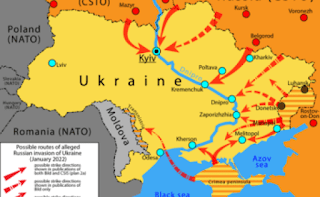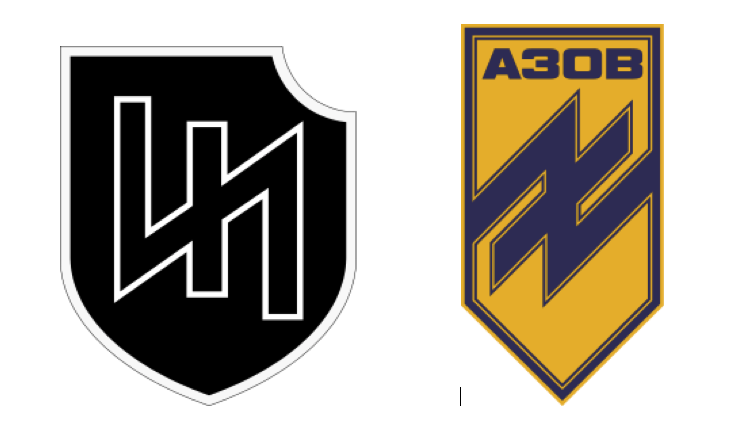The Western intelligence apparatus has been busy in Ukraine. With financing and collaboration through various non-governmental organizations, it won the information war with the help of Ukrainian media before Russia ever fired a shot in February. Even the country’s newest publications, like the Kyiv Independent, have received support and funding from institutions associated with the Central Intelligence Agency.
In most cases, these outlets have propagandized to the beat of the West’s war drums rather than inform the public.
Since the Independent launched last November, it has amassed nearly two million Twitter followers and become a main artery of information in the war. Far from being objective, its writers tend to snap at those who contradict their narratives. Illia Ponomarenko, the Independent’s defense reporter, even declared himself “brothers in arms” with Azov Battalion, a unit known for committing war crimes against civilians in eastern Ukraine. According to journalist Michael Tracey, Ponomarenko amassed almost a million followers in less than two weeks.
That kind of growth is hard and impressive. But the Independent also has some special connections.
The publication has a growing subscriber base today, but according to the Committee to Protect Journalists, it was created with an “emergency grant from the European Endowment for Democracy,” a spinoff of the National Endowment for Democracy. What is the NED? On the surface, it’s an NGO that promotes civil society worldwide by, among other things, sponsoring and providing training for journalists and activists directly or indirectly. The reality, however, is different.
Here’s ProPublica’s characterization: “The National Endowment for Democracy was established by Congress, in effect, to take over the CIA’s covert propaganda efforts. But, unlike the CIA, the NED promotes U.S. policy and interests openly.” The NED’s co-founder, Allen Weinstein, admitted as much. “A lot of what we do today was done covertly 25 years ago by the CIA,” he said in an interview with the Washington Post entitled, “Innocence Abroad: The New World of Spyless Coups.”
“The biggest difference is that when such activities are done overtly, the flap potential [i.e., embarrass or embroil the CIA in controversy] is close to zero,” Weinstein said. Recall that in 1967, Ramparts magazine humiliated the agency by exposing that it had turned the National Student Association’s international activities into “an arm of United States foreign policy” through undercover financing and secret collaboration. Now, “Openness is its own protection,” as Weinstein put it.
Put simply, the NED uses democracy movements to bring foreign governments into harmony with Washington’s interests. How that looks in practice takes different forms, including regime change. But a constant is formulating and managing narratives, which is why the NED has long funded media and activist groups. A recent report published by Declassified UK noted that the NED paid out more than $3 million between 2016 and 2021 to outlets like Bellingcat and the Thomson Reuters Foundation. Echoing Weinstein, a former CIA officer told Declassified that the NED is a “vehicle” for U.S. government “propaganda.”
The EED’s Facebook page refers to the Independent as a “partner,” and shows a close relationship with the NED.
In September 2021, a profile of the Independent’s chief editor, Olga Rudenko, appeared in ProMarket, a publication of the Stigler Center at the University of Chicago Booth School of Business. Rudenko was visiting the school for a journalism development program. According to ProMarket, she is also a board member at the Media Development Foundation, an NGO that has received at least $225,140 from the NED. You won’t find that without a digital archive because the NED’s records of funding projects in Ukraine was either moved or deleted recently. The archived page shows that from 2014 to the present, the NED has granted $22,394,281 through 334 awards to Ukraine. However, since the change, the NED only allows users to search back to 2017.
The MDF’s Facebook page features several posts referencing partnerships, exchange programs, and training affiliated with the NED that often conclude with an appreciative variation of: “to our partners National Endowment for Democracy, without them there would be nothing.” One post reads: “There is a donor National Endowment for Democracy who is very invested in the development of Ukrainian media.” Indeed, the MDF’s mission statement on the NED’s archived page also notes that it “will maintain and expand the Kyivpost.com website,” another key source of propaganda in the Ukraine-Russia war.
According to its LinkedIn page, the MDF was founded in 2013. That was the same year that a Western-backed coup in Ukraine got underway and when the EED launched. The NED and the EED have worked in tandem toward the same liberal internationalist vision ever since. Understanding their role in Ukraine’s political affairs and the media’s complicity helps explain how we got to the current crisis.
Modeled after the NED, the EED’s establishment was initially proposed in 2011 by Radosław Sikorski, a Polish journalist and a Member of the European Parliament. Speaking to donors that year, he said the “foundation would help develop democratic processes in the whole EU neighborhood—in Belarus, Egypt, Tunisia, Libya, Russia.” The Arab Spring has just been nurtured by an array of institutes financed through the NED.
Sikorski is also the husband of Anne Applebaum, a Polish-American staff writer for The Atlantic who sits on the NED’s board of directors. The EED’s Polish connection isn’t an accident. While serving as director of the CIA, James L. Pavitt declared, “Poland is the 51st state,” a former CIA official told the New York Times. “Americans have no idea.”
On paper, a sovereign Poland led the charge to create the EED and it is bankrolled by the European Commission. But that arguably just provides a layer of plausible deniability for its friends in D.C. It’s not hard to connect “the Blob” to the NED and the EED through characters like Victoria Nuland, who currently serves as President Joe Biden’s Under Secretary for Political Affairs.
A board member of the NED until last year, Nuland is married to Robert Kagan, a leading advocate of liberal interventionism. From 2018 to 2019, she served as CEO of the Center for a New American Security, a conflict of interest disguised as a think tank that has received funding from every major defense contractor, Wall Street’s biggest banks, and several foreign governments. Her career also spans several presidential administrations.
She was a staffer under President Bill Clinton from 1993 to 1996. Between 2003 to 2005, Nuland played an influential role during the U.S. invasion and occupation of Iraq as a key advisor to Vice President Dick Cheney. She acted as U.S. ambassador to NATO in Brussels from 2005 to 2008 and helped exacerbate tensions between Georgia and Russia.
Nuland is most notorious for her part in Ukraine’s 2013-2014 “Maidan Uprising,” a coup that saw the country’s government replaced with one approved by the Obama administration. The NED was key in that $5 billion effort to flip Ukraine.
Carl Gershman, who served as the NED’s president from its founding in 1984 until 2021, called Ukraine “the biggest prize” in September 2013 in the Washington Post. Jerzy Pomianowski, the EED’s first executive director and a former state secretary in Poland’s Ministry of Foreign Affairs, was just as candid as Gershman and Weinstein. Asked if the EED had a right to meddle in the affairs of foreign countries, Pomianowski said during an interview with Die Welt in January 2013, “we may not have the formal right to act everywhere. But we can.”
The EED became operational in the summer of 2013, just before the protests to oust Ukraine’s democratically elected—but insufficiently compliant—government began with the help of the U.S. State Department, where Nuland was Assistant Secretary of State for European and Eurasian Affairs. Nuland’s role in the regime change has led to her being called “the architect of American influence in Ukraine.”
But Nuland’s coup wouldn’t have been possible without the help of Ukrainian politician Oleh Tyahnybok and the Right Sector, which emerged as a confederation of paramilitary groups during the protests in November 2013. Its leader, Dmytro Yarosh, served as an aide to Ukrainian diplomat and politician Valentyn Nalyvaichenko. From late 2006 until early 2010, and from 2014 to 2015, Nalyvaichenko headed the Security Service of Ukraine (SBU), essentially the Ukrainian KGB successor.
Nuland referred to Tyahnybok in a leaked phone call as one of the “big three” opposition leaders on the outside who could help set up a new government approved by the Obama administration, led by Arseniy Yatsenyuk, on the inside. A separate but related exchange between EU Foreign Minister Catherine Ashton and Estonia’s Foreign Minister Urmas Paet further connected Tyahnybok and Nuland.
The two were involved in an inquiry to determine who was responsible for the violence during the protests. Police and civilians had been killed by sniper fire, and Ashton assumed it was then-President Viktor Yanukovych who was largely to blame. However, Paet’s intelligence suggested “that behind the snipers, it was not Yanukovych, but it was somebody from the new coalition.” In other words, an outside group had orchestrated the shootings on both sides to sow chaos.
The shootings were central to the protests because the victims’ deaths were propagandized by the media as evidence of Yanukovych’s tyranny. In their honor, a national memorial and an order of Ukraine were created. But not everything was as it seemed.
Right Sector militants were blamed for fanning the flames of violence. Some alleged that these groups were supported by the West. “Snipers were also trained in Poland” as “a favor to Washington,” said Polish politician Janusz Korwin-Mikke in an interview with Wirtualna Polska. When asked for evidence, he replied: “I am sitting in the European Parliament next to Mr. Urmas Paet, the Estonian Foreign Minister, who admitted in an interview with Baroness Catherine Ashton of Upholland that it was our people who shot on the Maidan.
“The democratic activists who participated in this coup were trained in Poland and this is no secret,” said Tomasz Sommer, now a non-resident research fellow with the Kosciuszko Chair of Polish Studies at the Institute of World Politics. Oleksandr Yakymenko, the head of the SBU at the time of the coup, also implicated Warsaw, claiming in an interview on Rossiya 24 television that “all orders were issued either from the Embassy of the United States or from the Embassy of the European Union.” The Polish Ministry of Foreign Affairs denied all allegations.
Yakymenko also claimed that Nalyvaichenko, Yarosh’s old boss and friend, had collaborated with U.S. intelligence while running the SBU. “CIA officials worked in the Ukrainian Security Service under Nalyvaichenko. The personal files of SBU officials were provided to them,” Yakymenko said. Notably, Nalyvaichenko, who replaced Yakymenko as head of the SBU after the coup, did not deny the possibility of the West backing the protests and said that the U.S. had an interest in exacerbating the situation in Ukraine.
In the end, Ashton and Paet did not pursue the inquiry further. But Estonia’s Foreign Ministry confirmed the call’s authenticity after it was leaked and sparked a scandal. Today, Yarosh is the primary commander of the Ukrainian Volunteer Army.
On Jan. 9, 2013, in the months leading up to the coup Nuland and the NED helped instigate, Ashton announced, as co-chair of the EED’s board of governors, that the “new initiative, largely inspired by the US-funded National Endowment for Democracy,” was beginning to take shape. EURACTIV, a media network focused on EU policies, noted that Ukraine’s leaders viewed the EED at the time with hostility because, they said, it “provokes unrest” and “weakens” the country. Nevertheless, Ashton declared in Brussels that the “Endowment comes at a very timely moment, as 2013 will be a crucial year for democratic transitions, in particular in the EU’s neighbourhood.”
“The European Endowment for Democracy can play a very important role,” she added. “By working directly with those in the field, who are striving for democracy; and by offering flexible, non-bureaucratic and dedicated procedures that are tailored to the needs and demands on the ground.”
The journalists and activists trained by intelligence-connected NGOs were so instrumental in shaping Western perceptions on the “revolution” that it has been called the “The Journalist Uprising.” But the myth of a democratic Ukraine is largely an NGO fantasy. The reality is that the country continues to be plundered by oligarchs and foreign governments, neither of which care much for the people of Ukraine.
Now, the Kyiv Independent continues the work of manufacturing and managing consensus.
As troops massed on Ukraine’s borders, Rudenko criticized Zelensky specifically and the West’s “megaphone diplomacy” generally in the New York Times. She said Russia had been “waging a war in eastern Ukraine since 2014,” and warned that should Zelensky make “any concession to Russia,” it “would likely bring hundreds of thousands of people to the streets—threatening him with the fate of Viktor Yanukovych, the president overthrown by a revolution in 2014.”
Rudenko curiously omitted the United States’ involvement in that “revolution.” Nor did she mention that the “war” in eastern Ukraine was triggered by Nuland’s coup when anti-government separatist groups declared independence from the Washington-approved regime. Indeed, there appears to be little daylight between Rudenko’s publication and D.C.’s liberal interventionists. The Independent uncritically amplifies President Volodymyr Zelensky’s false claims of Russian nuclear terrorism and demands for a no-fly zone—all of which, if acted upon, would result in a catastrophic escalation of the war.
It’s no surprise, then, that CIA Director Bill Burns recently told lawmakers that Russia “is losing” the information war. But what he really means, though, is that a false, Manichean narrative has emerged to absolve the West of all wrongdoing and inch us toward nuclear war. Supposedly, all in the name of “democracy.”
But “democracy” in Ukraine started a civil war that has raged for nearly a decade, with more than 14,000 dead before Russia even crossed the Rubicon. It meant turning Ukraine into the poorest country in Europe and using it as a proxy in the West’s new cold war, for which it is now paying dearly.







 When retail sales are calculated, they are calculated in dollars. Any recorded increase in retail sales that does not exceed the price increases in those items is factually reflecting a drop in units sold.
When retail sales are calculated, they are calculated in dollars. Any recorded increase in retail sales that does not exceed the price increases in those items is factually reflecting a drop in units sold.